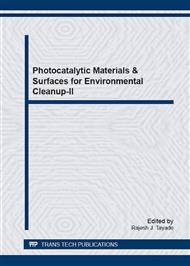[1]
A. Houas, M. Lachheb, M. Ksibi, E. Elaloui, C. Guillard, J.M. Herrmann, Photocatalytic degradation pathway of methylene blue in water, Applied Catalysis B: Environmental, 2001, 31, 145-157.
DOI: 10.1016/s0926-3373(00)00276-9
Google Scholar
[2]
M. Noorjahan, M.P. Reddy, V.D. Kumar, B. Lavedrine, P. Boule, M. Subrahmanyam, Photocatalytic degradation of H-acid over a novel TiO2 thin film fixed bed reactor and in aqueous suspensions, Journal of Photochemistry and Photobiology A: Chemistry, 2003, 156, 179-187.
DOI: 10.1016/s1010-6030(02)00408-2
Google Scholar
[3]
M.H. Habibi, M.N. Esfahani, T.A. Egerton, Photochemical characterization and photocatalytic properties of a nanaostructure composite TiO2 film, International Journal of Photoenergy, 2007, 13653, 1-8.
Google Scholar
[4]
S. Mahshid, M.S. Ghamsari, M. Askari, N. Afshar, S. Lahuti, Synthesis of TiO2 nanoparticles by hydrolysis and peptization of titanium isopropoxide solution. Semiconductor Physics, Quantum Electronics & Optoelectronics, 2006, 9(2), 65-68.
DOI: 10.15407/spqeo9.02.065
Google Scholar
[5]
U. Černigoj, Š.U. Lavrenčič, P. Trebše, K.U. Opara, S. Gross, Photocatalytically active TiO2 thin films produced by surfactant-assisted sol-gel processing, Thin Solid Films, 2006, 495, 327-332.
DOI: 10.1016/j.tsf.2005.08.240
Google Scholar
[6]
J.M. Valtierra, M.S. Cardenas, C.F. Reyes, S. Calixto, Formation of smooth and rough TiO2 thin films on fiberglass by sol-gel method, Journal of Mexican Chemical Society, 2006, 50(1), 8-13.
Google Scholar
[7]
N. Divya, A. Bansal, A.K. Jana, Surface modification, characterization and photocatalytic performance of nano-sized titania modified with silver and bentonite clay. Bulletin of Chemical Reaction Engineering & Catalysis, 2009, 4(2), 43-53.
DOI: 10.9767/bcrec.4.2.1249.43-53
Google Scholar
[8]
J. Kumar, A. Bansal, Photocatalytic degradation of amaranth dye over immobilized nano-crystals of TiO2, In proceedings of international conference on Energy & Environment, University of Cambridge, UK, (2010).
Google Scholar
[9]
L. Calvo, , A.F. Mohedano, J.A. Casas, M.A. Gilarranz and J.J. Rodr_ýguez, Treatment of chlorophenols-bearing wastewater through hydrotreatment using Pd/activated carbon catalysts. Carbon 2004, 42: 1377-1381.
DOI: 10.1016/j.carbon.2004.01.009
Google Scholar
[10]
Y. Liu, and S. Mou, Determination of bromate and chlorinated haloacetic acids in bottled drinking water with chromatographic methods. Chemosphere, 2004, 55: 1253-1258.
DOI: 10.1016/j.chemosphere.2003.12.023
Google Scholar
[11]
P. Pichat, , In: Photocatalytic Degradation of Pollutants in Water and Air: Basic Concepts and Applications. In: Tarr, M.A., Chemical Degradation Methods for Wastes and Pollutants: Environmental and Industrial Applications. Marcel Dekker, Inc., New York, Basel, 2003, pp: 77-119.
DOI: 10.1201/9780203912553.ch2
Google Scholar
[12]
R.J. Tayade, P.K. Suroliya, R.G. Kulkarni, R.V. Jasra, Photocatalytic degradation of dyes and organic contaminants in water using nanocrystalline anatase and rutile TiO2, Science and Technology of Advance Materials, 2007, 8: 455–462.
DOI: 10.1016/j.stam.2007.05.006
Google Scholar
[13]
R.J. Tayade, R.G. Kulkarni, R.V. Jasra, Photocatalytic degradation of aqueous nitrobenzene by nanocrystalline, Industrial and Engineering Chemistry Reaserch, 2006, 45: 922–927.
DOI: 10.1021/ie051060m
Google Scholar
[14]
S.T. Natarajan, M. Thomas, K. Natarajan, H.C. Bajaj and R.J. Tayade, Study on UV-LED/TiO2 process for degradation of Rhodamine B dye. Chemical Engineering Journal, 2011, 169: 126-134.
DOI: 10.1016/j.cej.2011.02.066
Google Scholar
[15]
C. Almquist, and P. Biswas, The photooxidation of cyclohexane on titanium dioxide: An investigation of competitive adsorption and its effects on products formation and selectivity. Applied Catalysis, 2000, 214: 259-271.
DOI: 10.1016/s0926-860x(01)00495-1
Google Scholar
[16]
P. Fernandez-Ibanez, S. Malato and O. Enea, Photochemical reactor for solar decontamination of water. Catalysis Today, 1999, 54: 329-339.
DOI: 10.1016/s0920-5861(99)00194-7
Google Scholar
[17]
K. Yoshiya,; M. Shin-ya; K. Hiroshi; O. Bunsho, Design, preparation and characterization of highly active metal oxide photocatalysts. Springer-Verlag, 2002 New York.
Google Scholar
[18]
M. Jassal, K.K. Gupta, A.K. Agrawal, Sol-gel derived titanium dioxide finishing of cotton fabric for self cleaning. Indian Journal of Fibre & Textile Research, 2008, 33: 443-450.
Google Scholar
[19]
Z. Zainal, C.S. Keng, A. H. Abdullah, Removal of cationic and anionic dyes by immobilized titanium dioxide loaded activated carbon. The Malaysian Journal of Analytical Sciences, 2008, 12 (2), 451-457.
Google Scholar


